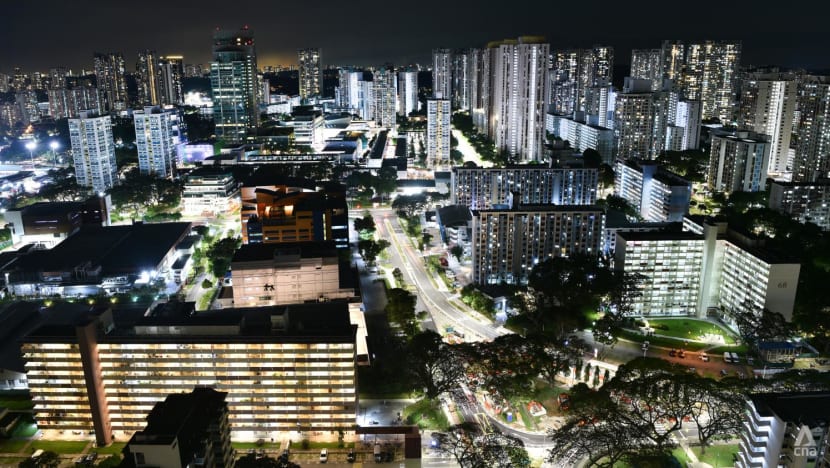EMA launches plan to tap backup generators, battery systems to boost Singapore's power grid reliability
Singapore's power grid needs to become more flexible and responsive to changes in supply and demand given the greater diversity in sources and loads, Minister in-charge of Energy and Science & Technology Tan See Leng said.


This audio is generated by an AI tool.
SINGAPORE: Singapore's power grid is expected to become more complex as demand for electric vehicles (EVs) grows and renewable but intermittent energy sources are introduced into the system.
To prepare for this shift, the Energy Market Authority (EMA) on Wednesday (Oct 29) launched a roadmap outlining measures to future-proof the power grid, including the use of "demand-side resources" to contribute to the country's energy needs.
Minister in-charge of Energy and Science & Technology Tan See Leng said the roadmap was key to ensuring grid flexibility, which is one of Singapore's priorities in securing its power grid.
Speaking at the Conference of the Electric Power Supply Industry, an event organised by SP Group and held in conjunction with the Singapore International Energy Week 2025, Dr Tan said that while Singapore's power grid is one of the most reliable in the world, the country's decarbonising efforts will pose new challenges.
Dr Tan noted that renewable energy sources were often located far from demand centres, resulting in long transmission lines. In addition, there could be operational challenges and uncertainties to the power grid given the intermittent nature of renewables such as solar energy.
Singapore's demand for electricity is also expected to grow with the increase in businesses and facilities that rely on large and steady supplies of electricity, such as data centres and EVs.
"Grid management will become more complex with these new load profiles", he added.
"To keep abreast of the energy transition, Singapore is focusing on three key priorities to future-proof our grid – specifically, on inter-connectivity, resilience, and flexibility," said Dr Tan. "After all ... there is no transition without transmission."
To address this, EMA will explore a demand-side flexibility roadmap aimed at allowing the grid to tap "underutilised" distributed energy resources such as battery energy storage systems and backup generators.
This means that such resources, which keep energy on standby when they are not being used, could be relied on for Singapore's power needs on a "near-continuous basis".
The authority said in a statement: "These resources are typically maintained on standby, placing them in a state of readiness that enables activation with short notice.
"Their capability to sustain load curtailment over extended periods suggests they could be well-positioned to provide ancillary services alongside their primary operational role."
Together, distributed energy resources and electricity users or facilities that require a continuous and high load of power can be a "potentially dependable and scalable means of contributing to system reserves", EMA said.
EMA will be publishing a request for information to explore the feasibility and design of a programme that can incentivise relevant parties to contribute to power grid reliability continuously, it said.
As part of this roadmap, EMA will also enhance its interruptible load programme, which is targeted at business consumers. The scheme allows eligible participants to be compensated for being on standby and to reduce their electricity demand when the grid faces tight supply constraints.
The authority plans to provide greater certainty to these participants during contingencies by reducing interruptible load activation period to 30 minutes. Implementation details have yet to be finalised.
EMA said the current pool of interruptible load resources was "opportunistic", as participants only reduce their load when schedules allow. These participants, who are mainly factories or production lines, cannot offer capacity consistently or for prolonged periods as they need to keep their own core operations running.
Dr Tan said EMA will also be launching a virtual power plant pilot programme.
Virtual power plants are digital platforms that can consolidate and optimise distributed energy resources such as solar and batteries as a single power source. The pilot will assess how these can address system needs.
REGIONAL POWER GRIDS
On inter-connectivity, Dr Tan said regional power grids play a key role in accelerating the energy transition.
"It allows us to maximise the region’s diverse renewable energy potential and strengthen grid resilience through mutual support," Dr Tan noted, pointing to concrete steps that have been taken towards realising the ASEAN Power Grid by 2045.
He noted that ASEAN leaders endorsed the terms of reference for the establishment of a subsea power cable framework at the 43rd ASEAN Ministers on Energy Meeting recently, which he described as a "very significant milestone".
"When realised, the framework will facilitate ASEAN member states in carrying out marine surveys, as well as the laying, maintenance and protection of subsea power cables in the region," he said.
















